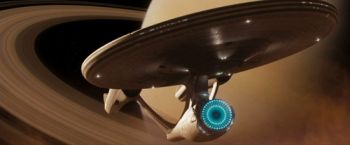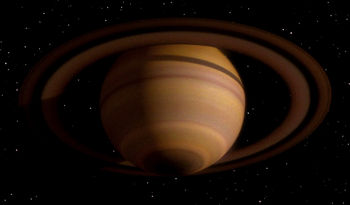Difference between revisions of "Saturn (Planet)"
From Trekipedia
| Line 1: | Line 1: | ||
| − | {{ | + | {{ImageInfoBox|name=Saturn|imgname=saturn-tng-101-102|caption=Saturn ([[Star Trek: The Next Generation|TNG]] [[Encounter at Farpoint (Episode)|101-102]])}} |
| − | {{ | + | {{TableRow|title=Affiliation|data=[[United Federation of Planets]]<ref name="TOS37"/>}} |
| − | + | {{TableRow|title=Distance from Star|data=1,426,980,000 [[kilometer|km]] (9.5 [[AU]])<ref name="STSC"/>}} | |
| − | + | {{TableRow|title=Orbital Period|data=24,209.8 rotations (29.46 [[Earth]] years)<ref name="STSC"/>}} | |
| − | + | {{TableRow|title=Rotational Period|data=10 hours, 40 minutes<ref name="STSC"/>}} | |
| − | + | {{TableRow|title=Class|data=[[Class J planet|J]]<ref name="STSC"/>}} | |
| − | + | {{TableRow|title=Cloudtop Temperature|data=-180°C<ref name="STSC"/>}} | |
| − | | | + | {{TableRow|title=Diameter|data=120,536 [[kilometer|km]]<ref name="STSC"/>}} |
| − | + | {{TableRow|title=Gravity|data=0.93 g<ref name="STSC"/>}} | |
| − | | 1,426,980, | + | {{TableRow|title=Natural Satellites|data=Ring system;<ref name="TOS37"/> 18 moons,<ref name="STSC"/> including [[Titan]]<ref name="ST11"/>}} |
| − | | | + | {{TableRow|title=Points of Interest|data=[[Starfleet Academy Flight Range]]<ref name="TNG219"/>}} |
| − | + | |}</div> | |
| − | | 24,209.8 rotations (29.46 years)<ref name="STSC"/> | ||
| − | | | ||
| − | |||
| − | | 10 hours, 40 minutes<ref name="STSC"/> | ||
| − | | | ||
| − | |||
| − | | [[Class J planet|J]]<ref name="STSC"/> | ||
| − | | | ||
| − | |||
| − | | -180°C<ref name="STSC"/> | ||
| − | | | ||
| − | |||
| − | | 120, | ||
| − | | | ||
| − | |||
| − | | 0. | ||
| − | | | ||
| − | |||
| − | | Ring system;<ref name="TOS37"/> 18 moons,<ref name="STSC"/> including [[Titan]]<ref name="ST11"/> | ||
| − | | | ||
| − | |||
| − | | [[Starfleet Academy Flight Range]]<ref name="TNG219"/> | ||
| − | |} | ||
| − | </div> | ||
Saturn, the sixth planet in the [[Sol system]],<ref name="TOS37"/> is home to the [[Starfleet Academy Flight Range]].<ref name="TNG219"/> | Saturn, the sixth planet in the [[Sol system]],<ref name="TOS37"/> is home to the [[Starfleet Academy Flight Range]].<ref name="TNG219"/> | ||
| − | {{ | + | {{BannerKelvin|width=700px}} |
| − | + | {{ImageBox|float=left|imgname=enterprise_1701-saturn-st11|caption=[[U.S.S. Enterprise NCC-1701 (Kelvin)|U.S.S. ''Enterprise'' NCC-1701]] at Saturn ([[Star Trek (Film)|ST11]])}} | |
| − | {{ImageBox|imgname=enterprise_1701-saturn-st11|caption=[[U.S.S. Enterprise NCC-1701 (Kelvin)|U.S.S. ''Enterprise'' NCC-1701]] at Saturn ([[Star Trek (Film)|ST11]])}} | ||
On [[Stardate]] [[Kelvin Chronology#2258|2258.42]], the [[U.S.S. Enterprise NCC-1701 (Kelvin)|U.S.S. ''Enterprise'' NCC-1701]] evaded detection by the ''[[Narada]]'' during its attack on [[Earth#Kelvin Timeline|Earth]] by coming out of warp in the atmosphere of Saturn's moon [[Titan]].<ref name="ST11"/> | On [[Stardate]] [[Kelvin Chronology#2258|2258.42]], the [[U.S.S. Enterprise NCC-1701 (Kelvin)|U.S.S. ''Enterprise'' NCC-1701]] evaded detection by the ''[[Narada]]'' during its attack on [[Earth#Kelvin Timeline|Earth]] by coming out of warp in the atmosphere of Saturn's moon [[Titan]].<ref name="ST11"/> | ||
{{References}} | {{References}} | ||
| Line 62: | Line 37: | ||
[[Category:Books]] | [[Category:Books]] | ||
[[Category:Comics]] | [[Category:Comics]] | ||
| − | + | {{CategoriesFASA}} | |
| − | |||
| − | |||
[[Category:LUG]] | [[Category:LUG]] | ||
[[Category:Decipher]] | [[Category:Decipher]] | ||
| − | + | {{CategoriesKelvin}} | |
| − | |||
Revision as of 00:30, 19 April 2020
Saturn
| Affiliation | United Federation of Planets[1] |
| Distance from Star | 1,426,980,000 km (9.5 AU)[2] |
| Orbital Period | 24,209.8 rotations (29.46 Earth years)[2] |
| Rotational Period | 10 hours, 40 minutes[2] |
| Class | J[2] |
| Cloudtop Temperature | -180°C[2] |
| Diameter | 120,536 km[2] |
| Gravity | 0.93 g[2] |
| Natural Satellites | Ring system;[1] 18 moons,[2] including Titan[3] |
| Points of Interest | Starfleet Academy Flight Range[4] |
Saturn, the sixth planet in the Sol system,[1] is home to the Starfleet Academy Flight Range.[4]

U.S.S. Enterprise NCC-1701 at Saturn (ST11)
On Stardate 2258.42, the U.S.S. Enterprise NCC-1701 evaded detection by the Narada during its attack on Earth by coming out of warp in the atmosphere of Saturn's moon Titan.[3]
Notes and References
- ↑ 1.0 1.1 1.2 Roddenberry, Gene (Executive Producer). "The Changeling." Star Trek, Season 2, Episode 8. Directed by Marc Daniels. Written by John Meredyth Lucas. Desilu Productions, 29 September 1967.
- ↑ 2.0 2.1 2.2 2.3 2.4 2.5 2.6 2.7 Mandel, Geoffrey. Star Trek: Star Charts. Pocket Books, 2002.
- ↑ 3.0 3.1 Abrams, J.J. & Damon Lindelof (Producers). Star Trek. Directed by J.J. Abrams. Written by Roberto Orci & Alex Kurtzman. Paramount Pictures. 8 May 2009.
- ↑ 4.0 4.1 "The First Duty". Star Trek: The Next Generation, episode 219. Television. Paramount Pictures Corporation, 30 March 1992.
